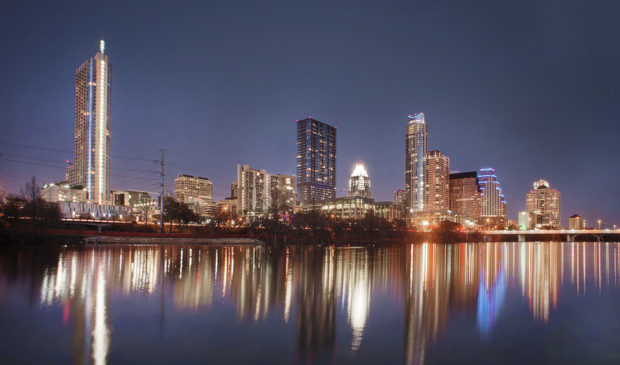Leaders say Austin’s Amazon hopes hang on transit, permitting issues
Tuesday, December 5, 2017 by
Chad Swiatecki While Amazon executives take the next few months or more to pick the location for a massive new second headquarters, Austin real estate and business leaders hope the national audition process has caused local leaders to think about much-needed improvements throughout the city.
That was one of the recurring discussion points at a panel organized by TeXchange technology advocacy group dedicated to the city’s strategy and the likelihood of landing the sought-after “HQ2” project. More than 200 cities in North America submitted proposals and the campus is expected to be more than 8 million square feet with 50,000 employees earning more than $100,000 each.
Outside analysis of contender cities has put Austin among a dozen or so likely winners, but the city’s lack of a comprehensive mass transit system is seen as its biggest weak spot.
Ryan Bohls, managing director of the real estate services firm Newmark Knight Frank, said transportation issues and a widely acknowledged as slow approval process for building permits are likely to cause Austin to lose out when the winning city is announced next year. Bohls told the Austin Monitor that he spent 16 months helping to negotiate Amazon’s 78,000-square-foot location at the Domain and that the city’s slow approval process for building improvements and finish-out caused a six-month delay on the company’s move-in date.
“A wait like that is not something that factors in well for them, and one of the things they think about is the time to get into the facility,” Bohls said. “There’s already a limited amount of permitting staff and this is going to go from 500,000 to eventually 8 million square feet. The current staff couldn’t handle that without causing substantial delays on all other projects.”
Bohls expects either Baltimore or Pittsburgh to beat out Austin in the selection, but said Austin leaders should begin examining the city’s infrastructure shortcomings to prepare for other potentially large economic development opportunities in the future.
“Transportation infrastructure is the first, last and most important consideration and it’s the biggest reason why companies have Austin fall by the wayside,” he said. “We have no meaningful public transit here and those systems are items that you can’t quickly scale. The business community continues to see that as the city’s number one priority.”
Tina Cannon, senior director of government relations for the Austin Chamber of Commerce, said the Amazon project has captured the imagination of the general public, in part because of the large hiring and salary numbers. And the highly public nature of the process is a big departure from what is more often a confidential and quiet vetting by companies looking for a combination of hiring talent, available real estate, economic incentives packages and more.
“There are six folks in economic development working on more than 100 opportunities at any one time, and they’re always talking to prospects,” she said. “Most companies tell you what they’re looking for but you don’t even get their name at first, so this is a very unique situation to have everything be so public.”
Cannon said the city’s current economic incentives package is designed for attracting large-campus projects for technology companies with hundreds of jobs or more, but she’s looking forward to the coming expansion of incentives to help recruit and grow smaller businesses.
Dan Graham, co-founder of BuildASign and the new Notley incubator, said the best hope for Austin to land the Amazon project is for city government officials to stay out of the process until a selection is made. Graham said that if Austin is chosen, then all levels of city government will need to work with the company to help them fit into the area chosen to build.
Graham said attendees at last week’s session saw the Domain or a stretch of fast-growing East Austin as the most suitable possible areas for Amazon to pick if Austin is chosen.
“There’s actions (City Council has) taken like trying to renege on the contract for the Domain or enacting policy that drove away companies like Uber and Lyft, and so the best thing would be to not take things to a negative place,” he said. “If it gets to the point where it’s actually happening, then they have to work on the infrastructure side to run all the scenarios for different locations and what things will look like in year five, year 10 and year 20. How does the area around (Amazon) develop, and how do they interact with the city as a whole are some of the important questions that will need to be answered.”
This story has been corrected to reflect that Dan Graham was commenting on sentiments expressed at the panel, not speaking on his own behalf.
Photo by Katie Haugland Bowen made available through Creative Commons.
The Austin Monitor’s work is made possible by donations from the community. Though our reporting covers donors from time to time, we are careful to keep business and editorial efforts separate while maintaining transparency. A complete list of donors is available here, and our code of ethics is explained here.
You're a community leader
And we’re honored you look to us for serious, in-depth news. You know a strong community needs local and dedicated watchdog reporting. We’re here for you and that won’t change. Now will you take the powerful next step and support our nonprofit news organization?









